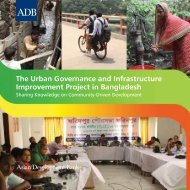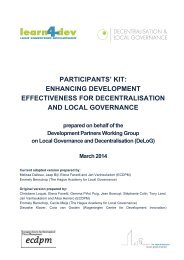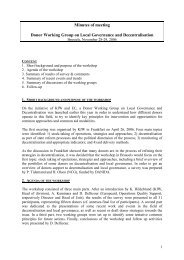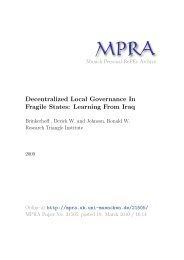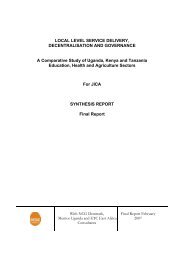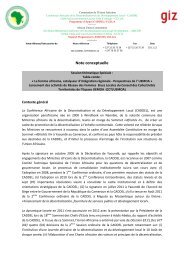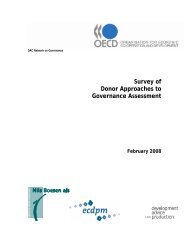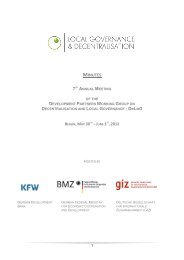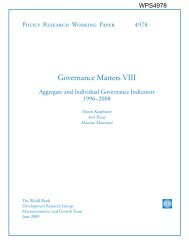Case stories on capacity development and sustainable results
Case stories on capacity development and sustainable results
Case stories on capacity development and sustainable results
Create successful ePaper yourself
Turn your PDF publications into a flip-book with our unique Google optimized e-Paper software.
40 Capacity: ResultsZAMBIA – Support tothe water sectorC<strong>on</strong>textAccess to safe drinking water is a keyfactor in the ec<strong>on</strong>omic <strong>and</strong> social <strong>development</strong>of any country. Zambia has apopulati<strong>on</strong> of 13.5 milli<strong>on</strong> people <strong>and</strong> anurbanizati<strong>on</strong> rate of 39 percent, but as recentlyas 2006 <strong>on</strong>ly two-thirds of the country’surban populati<strong>on</strong> had access to safedrinking water. This was largely due topoor town planning <strong>and</strong> investment strategies,al<strong>on</strong>g with inefficient managementstructures, unclear divisi<strong>on</strong> of resp<strong>on</strong>sibility,<strong>and</strong> rapid increases in Zambia’s urbanpopulati<strong>on</strong>.Development <strong>results</strong>Since 2006, the provisi<strong>on</strong> of safe watersupplies to urban dwellers has increasedfrom two-thirds of the populati<strong>on</strong> to morethan three-quarters. With combined investmentsin infrastructure <strong>and</strong> <strong>capacity</strong><strong>development</strong>, the installati<strong>on</strong> of 400ResultsInvestments in infrastructure <strong>and</strong> <strong>capacity</strong><strong>development</strong> have helped bring clean drinkingwater to more than 77 percent of urban dwellers.400 ‘water-kiosks’ have given 800,000 people inlow-income urban <strong>and</strong> peri-urban communitiesaccess to safe drinking water.‘water-kiosks’ has given 800,000 people inlow-income urban <strong>and</strong> peri-urban communitiesaccess to safe drinking water.The government is planning to exp<strong>and</strong>access to the entire urban populati<strong>on</strong> – anadditi<strong>on</strong>al estimated 2.85 milli<strong>on</strong> people –by 2015.Enhanced performanceThe 1994 Nati<strong>on</strong>al Water Policy reformedZambia’s water sector, which is regulated<strong>and</strong> ec<strong>on</strong>omically sustained by theNati<strong>on</strong>al Water <strong>and</strong> Sanitati<strong>on</strong> Council.Am<strong>on</strong>g the most significant outcomeswas the establishment of 11 CommercialWater Utilities, which provide water <strong>and</strong>sanitati<strong>on</strong> services to 92 percent of the urbanpopulati<strong>on</strong>.The optimizati<strong>on</strong> of instituti<strong>on</strong>al structures<strong>and</strong> processes has made water <strong>and</strong>sanitati<strong>on</strong> instituti<strong>on</strong>s perform better. Thisis part of an approach that has enhancedcapacities at the political, organizati<strong>on</strong>al,<strong>and</strong> individual levels, which has enabledresources to be managed more effectively<strong>and</strong> has produced tangible <strong>results</strong>.Training has enabled ministries, localgovernments, <strong>and</strong> utilities to identifytheir needs <strong>and</strong> plan for their organizati<strong>on</strong>al<strong>and</strong> infrastructure priorities. Forexample, the Nati<strong>on</strong>al Water <strong>and</strong> Sanitati<strong>on</strong>Council now m<strong>on</strong>itors the progressof commercial utilities <strong>and</strong> produces



